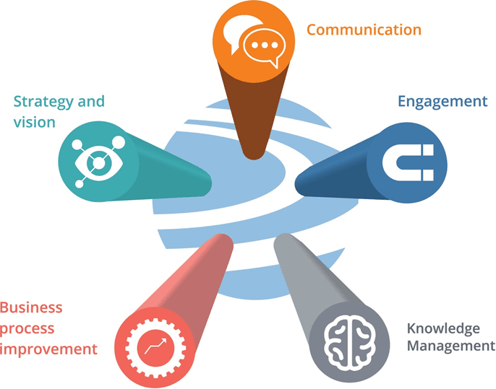
Before we start to think how we can achieve intranet success, we need to understand what our challenges are, what are the blockers preventing us achieve it? Again, these may differ in emphasis for your own intranet, but from the projects I have been involved in, I think the most common challenges are:
- Ensuring your intranet is on brand in terms of design, content and imagery
- Sustaining great engagement levels
- Optimising your knowledge management
- Understanding how your intranet can support your changing business
- How to demonstrate that your intranet is delivering a great return on investment
It’s important to understand that success isn’t achieved and then left, it’s a continual cycle of understanding your challenges, implementing a plan of action and then reviewing success. Here at Sorce we’ve developed the 5 pillars of success to help you frame your ideas to overcome these challenges.
I think this diagram helps to break down the broad areas that your intranet success is reliant upon.

5 Pillars to intranet success
1.Communication
This pillar relates to all the daily intranet challenges of design, content, imagery and branding. Often when you embark on a new intranet, a lot of time is spent on the design and branding. Your intranet may have a great name of its own and branding to complement. Copy is also hotly monitored in the beginning, training is provided for content contributors and everything looks and reads great. Over time however, colleagues move roles and sometimes the emphasis on quality content can lessen and the same with the design.
To overcome this, it’s always good to spot check your intranet and just keep an eye on the quality of the content and imagery. How often do you need to update your intranet design? To keep it fresh in the eyes of your users, some intranets have an annual design refresh.
2.Engagement
Sustaining great engagement levels is always a challenge and most intranets will experience waves of high engagement. To achieve success here I’ve always found it really helps to work with your intranet team and create an intranet marketing plan which just highlights headline campaigns, subject areas that can work as individual articles, blogs, competitions, polls. If you plan this activity out in advance, you can get as many people as needed to help with content, imagery and video. You can also then ensure that your intranet has some great fresh content on a regular basis.
Some ideas for engaging campaigns, include seasonal campaigns (festive season, summer holidays), you can create a campaign based upon a national day, such as national stress awareness day or even cat day!
3. Knowledge management
As a business it’s a high priority for many, that their intranets are the place where the business and individual knowledge is captured and shared. In practice this can be an ongoing work stream as you need to encourage all users to store their own work processes, documents and share their skills. You may need to approach this as one of your engagement campaigns, to highlight and share why this is important to your business and maybe include some examples where this has resulted in something extraordinary. Maybe knowledge management, enabled a new virtual team to come together to create or solve a business challenge.
4.Business process improvement
When you launched your intranet, you probably identified some key processes that your new intranet could change for the better. As with all the pillars this shouldn’t start and stop at launch. Every day your business is changing and growing and you should regularly review business processes and identify ways in which your intranet can improve or create new ways of working. You can’t be expected to know every business process, but by taking the time to meet with different teams or departments and asking for feedback on how they use the intranet, you can uncover a lot!
5. Strategy and vision
Thinking about your intranet success in terms of your business strategy and vision can ensure that your intranet is reflecting the same values and vision. It’s also a great help when it comes to demonstrating the value your intranet is bringing to the business in terms of return on investment and meeting its objectives.
As you know, your intranet objectives should be combination of soft and hard measures, so you might have set out to save £x on printing costs or increase business process by x time as your new intranet made an existing business process more efficient. To measure these and generate your return on investment is made easier if you can access an intranet dashboard.
If you can create your dashboard and set your objectives, whenever you login you can see how your intranet is performing and how close you are to achieving your objectives. You can then share these with the senior management team which helps keep the intranet front of mind.
I hope this blog has given you some ideas as to how to identify your intranet challenges and how you can frame your path to intranet success by using our 5 pillars. You might find our intranet insights useful, as it’s full of free downloads on return on investment, intranet project management and much more. If you are thinking about a new intranet, come along to one of our events.


